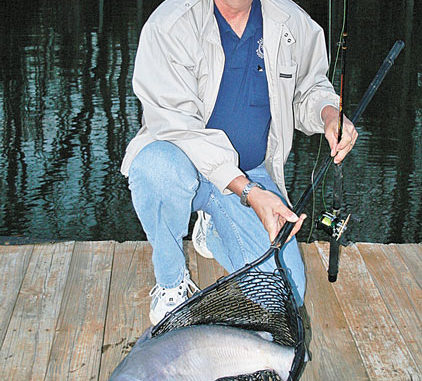
December may be a cold month in terms of temperature, but some of the fishing really heats up.
According to L.B. “Buster” Rush of Rush’s Guide Service, the action on catfishing is typically sensational by the middle of the month. Plus, the live-bait fishing and topwater schooling action is usually very good on stripers as well.
“December is when the cold-weather blue catfish fishery really kicks into high gear,” said Rush (803-478-4879). “While this fishing is good throughout the month, when the water temperature hits the 50-degree mark and then drops even lower, I consider it prime time for both quality and quantity of blue catfish. Catching some big fish is not unusual at all. While the exact timing of the bite will vary from year to year, the best fishing for the blues usually begins in December and runs into February.”
Rush said the key to catching plenty of winter catfish is to follow the shad. While most catfish caught are blues, flatheads and channels are also taken.
“When the water temperature drops, the shad get into big bunches or pods, and that’s what attracts the catfish,” Rush said. “So when fishing for catfish, I focus on finding schools of shad. Some fishermen will talk about finding the huge schools of shad all concentrated in one big glob, but I actually prefer to find an area where there are several bunches of smaller pods of shad. This usually means these shad have been broken up from a big school for some reason, and that reason is likely a bunch of blue catfish feeding on them.
Rush’s primary technique during the winter is to anchor and fan-cast around the boat.
“I’ll anchor in the midst of a place like I described and fan-cast 14 rods out around the boat,” he said. “I will use shad as bait, and if the shad I have are small, I’ll put two to a hook. If they’re larger, I may use just one. Sometimes, I’ll experiment and even use cut shad. However, when you get into a good bunch of feeding blue catfish, they’ll devour the shad however you present it.”
When searching for catfish, Rush said he’ll give a place no more than 20 minutes before moving on to another shad-rich environment.
“If I don’t get catfish bites in 20 minutes, I figure I’ve picked the wrong spot, and I move,” he said. “However, if I get into some catfish action that’s productive and then it slows, I’ll usually wait about 30 minutes before moving to a new spot. Catfish, especially the blues, will cruise around a good bit, and often if you stay put for 20 to 30 minutes, you’ll be back into catfish action without having to make a move.”
While Rush doesn’t guide for stripers, he has fished for them a lot in the past and still keeps up with what’s happening on Lake Marion and Lake Moultrie.
“December is a very good month for striper fishing,” Rush said. “Plus, the new regulations that have gone into effect on Santee Cooper do seem to be working. We’re seeing more and better-sized striper being caught. It does look like the fishery is coming back.”
Rush said the topwater schooling action is usually very this month, and a lot of fishermen will use soft, plastic-bodied swimming lures when they are surface feeding. He also said bucktails will usually produce action as well.
“Also, drifting live bait through the schools will be very productive,” he said. “You can drift the area where fish have been schooling or they can be marked on the graph, and drift-fishing with the bait set just above where the fish are marked is very productive as well.”
Rush does guide for crappie, but he said that December is usually a slow month for slabs.
“I have caught some crappie fishing deep brush along the old river channel in the lower end of Lake Marion,” he said, “but the catfishing is usually so good I generally don’t crappie fish much at this time of the year. But I know some of the crappie fishermen who do well in the upper end of Lake Marion by fishing the deep brush along the river channel. Often the fish will be found over the deep brush, suspended in 18 to 20 feet of water, over 27 to 32 feet of water.”
Rush said that overall the crappie population has improved considerably in Santee Cooper, and the fall of 2010 provided excellent crappie fishing, so he’s looking for a great spring season in 2011.




Be the first to comment